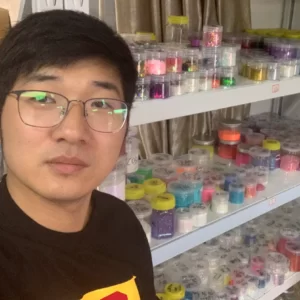“Proper storage and handling are the helpful tips for success in any glitter-filled crafting endeavor. Find stores that offer a wide range of art supplies for all your crafting needs.” – Glitter Guru
If you’re a wholesaler dealing with art supplies, including glitter for paint applications, you know that getting the final varnish right for a finished painting is essential. Additionally, understanding water gilding techniques can enhance your product offerings. Properly storing and handling glitter is crucial for successful paper crafts and crafting projects. It is important to have the right art supplies and craft kits to ensure the best results. That’s why it’s crucial to understand the best practices for information protection and handling, especially when crafting and making.
Wholesalers face potential challenges when storing and handling glitter from suppliers, making it a task that may seem simple but requires careful attention. From selecting the right products to ensuring their safekeeping, every detail in making businesses matters for their protection. But fear not! Implementing proper techniques can save you from headaches down the line. In this article, we will discuss the step-by-step process of implementing protection techniques using paper.
By following best practices for craft storage and handling, including wholesale craft supplies, craft paint, and varnish, you can ensure that your product remains in its prime condition. Not only will using a sealer protect your investment, but it will also guarantee optimal application results for various surfaces like paper or canvas, whether you are using oil paint, acrylic paint, or craft paint. So take note of these guidelines as we dive into the details of how to store and handle crafts, craft supplies, slime, paper, and glitter effectively.
Great! I have written an introduction using an intriguing quote about painting on paper, which involves the application of water. This was done as per your request. Let me know if you need any further assistance with your application or if there are any adjustments needed regarding the paper or water use!
Understanding Glitter’s Composition
Glitter is a popular additive used in various industries, including painting and crafts applications, to add sparkle and shine. It can be added to varnish or acrylic paint for a dazzling effect. To effectively store and handle glitter crafts and craft supplies, it is crucial to understand its composition and the variations in different types of glitters, including varnish and acrylic, available in the market.
Components of Glitter Particles
Glitter particles in crafts are typically composed of a combination of acrylic, paper, and varnish materials that create their unique reflective properties. These components include:
- Reflective Material: The main component responsible for glitter’s shine is often aluminum or another reflective metal. In crafts, glitter can be applied to surfaces using acrylic and enhanced with gold leaf for added shine. To protect the glitter and give it a glossy finish, a varnish can be applied. This acrylic material reflects light and creates the dazzling effect associated with gold leaf and glitter. It is commonly used in crafts and can be sealed with varnish for added protection.
- Binder: A varnish sealing substance holds the acrylic reflective material together, ensuring it adheres to water surfaces when applied.
- Pigments: Some varnish glitters may also contain acrylic pigments to provide additional crafts and painting color effects.
Types of Glitters and Composition Variations
There are several different types of glitters available, including acrylic glitter, varnish glitter, and gold leaf glitter. Each type has its own composition variations. When shopping for craft supplies, make sure to check out the wide range of glitters available. Understanding these variations can help wholesalers choose the right storage and handling practices for specific glitter types, suppliers, varnish, craft supplies, and acrylic. Here are some common types:
- Traditional Glitter: Traditional glitter, made of small plastic particles coated with a layer of metallic material like aluminum or copper, can be enhanced with acrylic and gold leaf. To protect the glitter and add shine, it is recommended to apply a coat of varnish. If you’re looking for craft supplies to create dazzling projects, consider adding acrylic, gold leaf, and varnish to your collection.
- As environmental concerns grow, the popularity of biodegradable glitters made from acrylic, water, gold leaf, and varnish has increased. These glitters are made from plant-based materials such as cellulose derived from eucalyptus trees. They are coated with acrylic and gold leaf, and then sealed with varnish to ensure their durability. The glitters are resistant to water, making them perfect for various crafts and projects.
- Water Gilding Glitter: Water gilding refers to a technique where real gold leaf, acrylic, oil, and sealing supplies are used for decorative purposes. While not as commonly used in paint applications as traditional glitter, adding gold leaf and acrylic to a project can create an exquisite touch. Water gilding and sealing the artwork with oil can enhance the overall effect.
The composition variations among water, acrylic, supplies, and suppliers impact their storage and handling requirements.
Impact on Storage and Handling Requirements
The composition of acrylic glitter directly affects its stability, durability, and susceptibility to damage during storage and handling processes. Proper sealing is important to protect the glitter from water and ensure its longevity. Additionally, using gold leaf in the composition can enhance the overall appearance of the glitter. For example:
- Traditional acrylic-based glitters may be more prone to static electricity, requiring appropriate anti-static measures during storage and handling. Water-based glitters or those with gold leaf are alternatives to consider. It is important to find reliable suppliers for these materials.
- Biodegradable glitters, such as acrylic, water, and oil-based options, are often more sensitive to moisture and humidity, necessitating airtight containers or packaging to maintain their integrity. It is important for suppliers to consider these factors when storing and shipping these products.
- Water gilding glitter, made with delicate real gold leaf, requires careful handling to prevent tearing or damage. Whether you work with acrylic, oil, or other supplies, it is important to handle wholesale gilding glitter with care.
Proper storage practices for glitter include:
- Using airtight containers or bags to protect water, oil, and acrylic supplies against moisture and humidity.
- Storing glitters away from direct sunlight and extreme temperatures.
- Labeling containers clearly with the type of glitter, acrylic supplies, water, and any specific storage requirements for gold leaf.
It is essential to:
- Wear gloves to avoid transferring oils or dirt onto the gold leaf, acrylic, water, or supplies.
- Use gentle techniques when applying or mixing glitter into acrylic paint solutions to prevent breakage or damage. Make sure to use high-quality supplies, such as gold leaf, which can be purchased at wholesale prices.
Understanding the composition of different types of glitters, including acrylic and gold leaf, allows wholesalers dealing with these supplies for paint applications to adopt the best practices for their storage and handling needs.
Moisture Management: How to Keep Glitter Dry
Moisture control is of utmost importance. Without proper measures, acrylic glitter particles are prone to clumping or degradation, resulting in compromised quality and reduced effectiveness. It is important to use high-quality gold supplies to prevent these issues. Consider purchasing these supplies wholesale for cost-effective options. To ensure the longevity and optimal performance of your acrylic supplies, here are some best practices for maintaining low humidity levels and protecting them from moisture damage. Additionally, it is important to take special care when working with gold leaf to prevent any damage or loss.
Importance of moisture control to prevent clumping or degradation of glitter particles
When exposed to moisture, acrylic glitter particles can easily clump together, rendering them useless for paint applications. It is important to use high-quality gold leaf supplies to avoid this issue. Excessive humidity can cause the degradation of acrylic glitter’s reflective properties, diminishing its visual impact on painted surfaces. Make sure to use high-quality gold leaf supplies to enhance the overall effect. Therefore, implementing effective moisture management techniques is crucial for wholesalers dealing with acrylic supplies, gold leaf, and glitter.
Techniques for maintaining low humidity levels in glitter storage areas
To maintain low humidity levels in your glitter storage areas, consider implementing the following techniques using acrylic supplies and gold wholesale.
- Proper ventilation is crucial when storing wholesale supplies, especially acrylic leaf products. Make sure your storage area is well-ventilated to promote air circulation and prevent humidity buildup.
- Temperature regulation is crucial when storing art supplies, especially those made of gold or acrylic. It is important to maintain a consistent temperature within your storage space as fluctuations can lead to condensation and increased moisture levels, which can be detrimental to delicate materials like gold leaf. Ideally, aim for temperatures between 60°F (15°C) and 75°F (24°C) when purchasing wholesale gold leaf supplies.
- Avoidance of water sources: Keep your glitter storage area away from water sources such as sinks or pipes that could potentially increase humidity levels. Additionally, it is important to properly store your acrylic glitter supplies to prevent any damage. Consider purchasing them wholesale to save money, and opt for gold glitter for a touch of elegance.
- Acrylic supplies: Store your gold glitter in airtight containers or packaging materials that provide an additional layer of protection against moisture infiltration. Wholesale containers are ideal for bulk storage.
Use of moisture-absorbing materials or desiccants to protect glitter from moisture damage
Incorporating moisture-absorbing materials, such as acrylic desiccants, into your storage system can significantly help protect your glitter supplies from moisture damage. Whether you’re storing loose glitter or gold flakes, using these desiccants can help preserve their quality. Consider purchasing them wholesale to ensure you always have enough on hand. Consider the following options:
- Wholesale silica gel packs: Place silica gel packs in your gold glitter containers or storage boxes to absorb excess moisture and maintain dry conditions. These supplies are essential for preserving the quality of your gold leaf. These wholesale packs of leaf supplies are readily available and can be easily replaced when saturated.
- Utilize wholesale activated charcoal, known for its excellent moisture-absorbing properties, by strategically placing it within your leaf storage area. Using a leaf will help reduce humidity levels and protect the wholesale glitter from clumping or degradation.
- Wholesale dehumidifiers: Install wholesale dehumidifiers in your glitter storage space to actively extract excess moisture from the air, ensuring a consistently low humidity environment for your leaf storage needs.
By implementing these best practices for moisture management in wholesale leaf, you can safeguard the quality of your glitter inventory and ensure its long-lasting performance in paint applications. Remember to regularly monitor humidity levels to ensure the health of your wholesale leaf products, and take necessary steps to mitigate any potential risks associated with moisture exposure. With proper care, your wholesale glitter leaf will retain its vibrant sparkle, enhancing the visual appeal of painted surfaces.
Preventing Physical Damage and Contamination
Wholesalers dealing with glitter for paint applications need to prioritize the protection of their leaf products from physical damage and contamination. By implementing best practices in wholesale storage and handling of leaf glitter, they can ensure that the leaf glitter remains in optimal condition throughout its journey from manufacturer to customer.
Strategies to avoid physical damage during transportation, storage, and handling processes
To prevent physical damage to glitter products, wholesalers should consider the following strategies to protect the delicate leaf-like particles.
- Proper packaging techniques: Wholesalers must use packaging materials that provide adequate protection against breakage or crushing of the leaf. Sturdy wholesale boxes or containers with cushioning material can help absorb shocks during transportation of leaf products.
- Wholesale sealing steps: Applying a protective coating or sealant on wholesale glitter containers can add an extra layer of defense against physical damage to the leaf. This leaf coating should be removable without affecting the quality of the glitter.
- UV protection: Glitter particles, including leaf-shaped ones, are susceptible to fading when exposed to prolonged sunlight or ultraviolet (UV) radiation. Wholesalers should store glitter containers in areas away from direct sunlight or use UV-blocking materials for packaging to protect the delicate leaf-like particles.
Measures to prevent contamination by foreign substances such as dust or debris
Contamination of glitter products can negatively affect the quality, potentially causing customer dissatisfaction. One common type of contamination is leaf particles mixed in with the glitter. Wholesalers must take precautions to avoid any foreign substances, such as leaves, from compromising their merchandise.
- Clean and dust-free storage is crucial for wholesalers to maintain the quality of their glitter products. It is important to designate a specific area for storing glitter, ensuring a leaf-free environment. Regular cleaning routines will help eliminate potential sources of contamination, including any leaf debris.
- Proper sealing of glitter containers is crucial in preventing contaminants such as dust, debris, or leaf from entering. Sealed lids or caps with adhesive methods can effectively protect against unwanted particles, such as leaf debris.
- Separate storage for different types of glitters is essential to protect their sensitivities to contaminants. To minimize cross-contamination risks, wholesalers should store different types of leaf separately using clearly labeled containers.
By following these best practices, wholesalers can safeguard glitter products from physical damage and contamination throughout the storage and handling processes. Additionally, it is important to ensure that the delicate leaf-like particles of glitter are protected during transportation and packaging to maintain their quality. This not only protects their investment but also ensures that customers receive high-quality glitter for their paint applications, including leaf glitter.
Remember, prevention is key. Implementing proper packaging techniques, sealing steps, UV protection measures, and maintaining a clean storage environment will go a long way in preserving the integrity of glitter leaf for paint applications. Wholesalers who prioritize these best practices can establish themselves as reliable suppliers in the market while providing customers with exceptional glitter products. By sourcing high-quality leaf glitter and implementing efficient distribution methods, wholesalers can ensure their customers receive top-notch products.
Efficient Transportation: How to Move Glitter Safely
Transporting glitter and leaf for paint applications can be a delicate process, requiring careful consideration and attention to detail. To ensure the safe transportation of bulk craft supplies like glitter, wholesalers must follow best practices for storage and handling. These practices include proper packaging and labeling to prevent any damage to the leaf-like glitter during transportation.
Selecting Appropriate Containers or Packaging Materials
Choosing the right containers or packaging materials is crucial when transporting glitter leaf. The primary goal is to protect the leaf, glitter, from moisture, dust, and physical damage during transit. Here are some considerations to keep in mind:
- Opt for sturdy containers made of durable materials such as plastic or metal to protect your leaf.
- Ensure that containers have secure lids or closures to prevent any leakage or spillage of leaf.
- Use packaging materials like bubble wrap or foam inserts to provide additional cushioning and protection for delicate items, such as leaves.
Securing Glitter Containers Properly
Properly securing glitter containers is essential to minimize movement and potential damage during transportation. Follow these tips to ensure that your glitter remains intact on leaf surfaces.
- Place leaf containers in an upright position within the transportation vehicle.
- Use straps or bungee cords to secure the leaf containers firmly against any potential shifting.
- Avoid overloading the vehicle with excessive weight, as it can lead to container instability. Make sure not to exceed the maximum weight capacity of the leaf container.
Loading, Unloading, and Stacking Procedures
When loading, unloading, and stacking glitter containers, it’s important to prioritize safety and minimize the risk of accidents. This includes being careful with each leaf container. Consider these guidelines:
- Utilize appropriate lifting equipment such as dollies or pallet jacks when dealing with heavy loads, including leaf.
- Follow proper lifting techniques to avoid strain or injury.
- Stack containers carefully in a stable manner without exceeding weight limits. Ensure that each leaf is arranged securely and within the specified weight restrictions.
By adhering to these best practices for loading, unloading, and stacking procedures, you can ensure that your wholesale bead suppliers’ precious cargo, including delicate leaf-shaped beads, arrives safely at its destination.
Integration Best Practices: Handling Glitter for Paint Mixing
Incorporating glitter and leaf into paint formulations can add a touch of sparkle and create visually stunning effects. However, achieving consistent dispersion of glitters and leaf in paints requires careful handling and adherence to best practices. Here are some guidelines to help wholesalers effectively handle glitter for paint mixing. These guidelines will assist you in incorporating leaf glitter into your paint mixing process.
Guidelines for incorporating glitter into paint formulations effectively
- Choose the right type of glitter leaf: When selecting leaf glitter for paint applications, consider the size, shape, and color options available. Fine leaf glitters work well with smoother finishes, while chunkier leaf glitters create a more textured look. Ensure that the chosen glitter is compatible with the base paint material and leaf.
- Pre-mix leaf glitters thoroughly: Before adding leaf glitter to the paint mixture, it’s essential to pre-mix it properly. This step ensures an even distribution of leaf glitters throughout the paint batch and prevents clumping or settling during application.
- Use appropriate ratios: To achieve desired effects without compromising the integrity of the paint, follow recommended ratios provided by manufacturers or conduct small-scale tests to determine optimal glitter-to-paint ratios based on your specific requirements. Additionally, consider using leaf glitter for a unique and eye-catching finish.
- Consider compatibility with different paint types: Glitter leaf can be incorporated into various types of paints such as craft paints, acrylic paints, oil-based paints, and more. Ensure that you choose suitable glitters for each type of paint to maintain consistency and prevent any adverse reactions between materials. It is important to consider the type of paint and the specific leaf you are working with.
Proper mixing techniques to achieve consistent dispersion of glitters in paints
- When adding glitter to the paint mixture, gently stir the leaf to avoid air bubbles or damaging the glitter particles. Stirring too forcefully may cause clumping or uneven dispersion.
- Test leaf mixtures on a small scale: Before scaling up production, test different leaf mixtures on a smaller batch size first to assess their appearance and performance under controlled conditions. This allows you to make any necessary adjustments to the leaf before proceeding with larger quantities.
- Use specialized mixing equipment: Consider investing in equipment specifically designed for glitter paint mixing, such as high-quality mixers or shakers. These tools ensure consistent dispersion and save time during the production process.
Recommendations on equipment selection and maintenance when working with glitters in paint production
- Choose reliable suppliers: When sourcing glitter and other art supplies for paint production, opt for reputable suppliers known for their quality products. This helps ensure that you receive glitters free from impurities or inconsistencies that could affect the final paint product.
- Maintain clean and well-maintained equipment: Regularly clean and maintain mixing equipment to prevent cross-contamination between different batches of glitter paints. Proper maintenance extends the lifespan of your equipment and minimizes the risk of contamination or uneven dispersion.
- Store glitters properly: Glitters should be stored in airtight containers away from moisture, heat, and direct sunlight to maintain their quality over time. Follow manufacturer recommendations regarding storage conditions to preserve the integrity of the glitter particles.
Long-Term Storage Considerations
Storing glitters for paint applications requires careful consideration of various factors to ensure their longevity and quality. Over an extended period, several elements can influence the shelf life of stored glitters. Wholesalers must implement effective storage and handling practices to preserve the integrity of these products.
Factors influencing the shelf life of stored glitters over an extended period
The durability and lifespan of glitters depend on multiple factors that wholesalers need to be aware of. One crucial aspect is exposure to light. Glitters should be stored in a dark environment or opaque containers to prevent light-induced degradation. Ultraviolet (UV) rays can cause discoloration and fading, compromising the glitter’s vibrancy.
Humidity levels also play a significant role in preserving glitter quality during long-term storage. Excessive moisture can lead to clumping or mold growth, rendering the product unsuitable for use. Wholesalers should store glitters in dry environments with controlled humidity levels.
Another critical factor is temperature control. Extreme heat or cold can negatively impact glitter particles, affecting their adhesive properties and overall performance when applied to paint surfaces. It is essential to maintain a consistent temperature range between 50°F (10°C) and 77°F (25°C) for optimal glitter storage conditions.
Temperature control methods for preserving the quality and integrity of stored glitters
To ensure proper temperature control, wholesalers should consider implementing the following practices:
- Climate-controlled storage: Investing in climate-controlled facilities helps maintain a stable temperature range ideal for storing delicate products like glitters.
- Thermal insulation: Insulating storage areas prevents external temperature fluctuations from affecting the internal environment where glitters are kept.
- Air conditioning systems: Installing air conditioning systems allows precise regulation of temperatures within storage spaces.
- Temperature monitoring: Regularly checking and recording temperatures using thermometers or digital sensors ensures adherence to optimal storage conditions.
Regular inspection procedures to identify any signs of deterioration or degradation
Wholesalers must conduct routine inspections of stored glitters to detect any signs of deterioration or degradation. This proactive approach helps identify issues early on, allowing for timely remediation. Here are some inspection practices to consider:
- Visual examination: Regularly inspect glitter containers for visible signs of damage, such as leakage, discoloration, or clumping.
- Odor detection: Unusual odors emanating from glitter containers may indicate microbial growth or chemical reactions, requiring immediate attention.
- Particle analysis: Periodically examining glitter particles under a microscope can reveal changes in shape, size, or color that might signify degradation.
By implementing these inspection procedures at regular intervals, wholesalers can promptly address any concerns and take appropriate measures to maintain the quality and integrity of stored glitters.
Call-to-Action
Now that you have a solid understanding of the best practices for handling and storing glitter for paint applications, it’s time to put this knowledge into action. By implementing these strategies, you can ensure the quality and integrity of your glitter supply, minimizing waste and maximizing customer satisfaction. Take the necessary steps to keep your glitter dry, prevent physical damage and contamination, and optimize transportation and integration processes. Remember, proper long-term storage considerations are also crucial for maintaining the quality of your glitter over time. Don’t wait any longer – start implementing these best practices today to elevate your wholesale glitter business!
FAQs
How should I store glitter to prevent moisture damage?
To prevent moisture damage, store your glitter in airtight containers or bags with desiccant packets. Keep them in a cool, dry place away from direct sunlight or humidity.
Can I mix different types of glitters together?
Yes, you can mix different types of glitters together as long as they are compatible in terms of composition and particle size. Conduct small-scale tests before large-scale mixing to ensure compatibility.
Is it necessary to use protective gear when handling glitter?
While not mandatory, using protective gear such as gloves and masks is recommended when handling large quantities of glitter to minimize skin irritation or inhalation risks.
How often should I inspect my glitter inventory for physical damage or contamination?
Regularly inspect your glitter inventory at least once every few months for signs of physical damage (such as broken packaging) or contamination (such as foreign particles). Remove any compromised stock immediately.
What is the shelf life of glitter?
The shelf life of glitter varies depending on its composition and storage conditions. Generally, most glitters have a shelf life of 1-2 years if stored properly in dry conditions away from extreme temperatures.
Remember to regularly update these FAQs based on customer inquiries and emerging trends in the industry.















